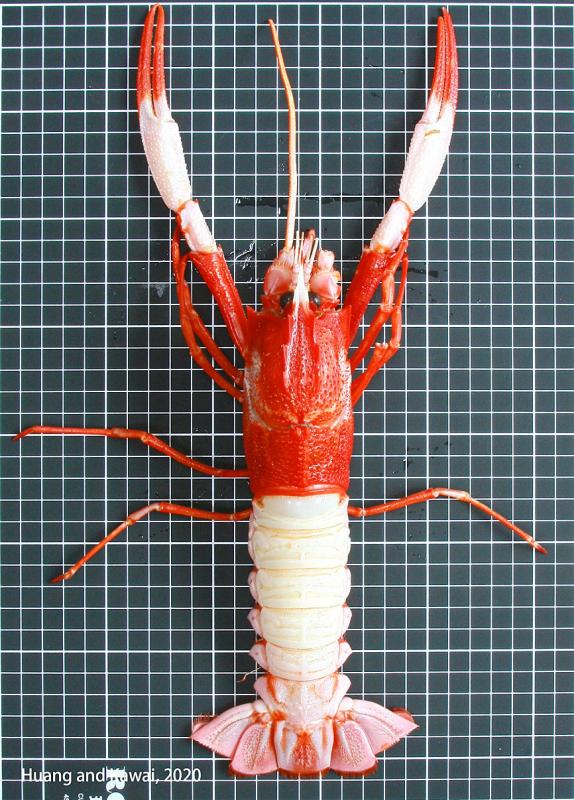A lobster species rarely caught by local fishers earlier this month was included for the first time on TaiBNET (Catalogue of Life in Taiwan) maintained by the Biodiversity Research Center at Academia Sinica, thanks to a biologist.
Huang Ming-chih (黃銘志), an associate professor in the Department of Biological Sciences and Technology at National University of Tainan, acquired 10 Neptune lobsters (Metanephrops neptunus) from fishers at Cheng Pin port in Keelung, the school said in a statement released on Thursday.
The lobsters were caught in waters close to the Pratas Islands (Dongsha Islands, 東沙群島) in the South China Sea in July last year, the statement said.

Photo: CNA
Known locally as red-head lobsters, the lobsters are rarely seen among the catches of local fishers, with fewer than 40 caught each year and they are one of the most expensive items sold at Keelung seafood market, it said.
Of the 10 lobsters Huang acquired, three were ovigerous females and seven mature males, which facilitated more detailed research into the species, it added.
Relatively little is known about the species, and only minimal research has previously been conducted domestically or internationally, Huang told the Central News Agency.
Registering the lobster on TaiBNET represents the first step in seeking to protect the species, he said.
Huang thanked Tadashi Kawai, chief researcher at the Hokkaido Research Organization, part of Japan’s Central Fisheries Research Institution, for his assistance in identifying the rare species, recording its features and providing pictures.
An article based on their joint observations has been published in the latest edition of Crustacean Research.
The 10 Neptune lobsters have since been donated to National Taiwan Museum in Taipei as specimens for academic researchers to use in their work, Huang said.
The Neptune lobster, which has a red head and white abdomen, was first discovered in the South China Sea in 1965.
It is 18cm to 25cm in length and is mainly found at a depth of 300m to 600m in the South China Sea and the Indian Ocean west of Australia.

Taiwan is to receive the first batch of Lockheed Martin F-16 Block 70 jets from the US late this month, a defense official said yesterday, after a year-long delay due to a logjam in US arms deliveries. Completing the NT$247.2 billion (US$7.69 billion) arms deal for 66 jets would make Taiwan the third nation in the world to receive factory-fresh advanced fighter jets of the same make and model, following Bahrain and Slovakia, the official said on condition of anonymity. F-16 Block 70/72 are newly manufactured F-16 jets built by Lockheed Martin to the standards of the F-16V upgrade package. Republic of China

Taiwan-Japan Travel Passes are available for use on public transit networks in the two countries, Taoyuan Metro Corp said yesterday, adding that discounts of up to 7 percent are available. Taoyuan Metro, the Taipei MRT and Japan’s Keisei Electric Railway teamed up to develop the pass. Taoyuan Metro operates the Taiwan Taoyuan International Airport MRT Line, while Keisei Electric Railway offers express services between Tokyo’s Narita Airport, and the Keisei Ueno and Nippori stations in the Japanese capital, as well as between Narita and Haneda airports. The basic package comprises one one-way ticket on the Taoyuan MRT Line and one Skyliner ticket on

Starlux Airlines, Taiwan’s newest international carrier, has announced it would apply to join the Oneworld global airline alliance before the end of next year. In an investor conference on Monday, Starlux Airlines chief executive officer Glenn Chai (翟健華) said joining the alliance would help it access Taiwan. Chai said that if accepted, Starlux would work with other airlines in the alliance on flight schedules, passenger transits and frequent flyer programs. The Oneworld alliance has 13 members, including American Airlines, British Airways, Cathay Pacific and Qantas, and serves more than 900 destinations in 170 territories. Joining Oneworld would also help boost

A new tropical storm formed late yesterday near Guam and is to approach closest to Taiwan on Thursday, the Central Weather Administration (CWA) said. Tropical Storm Pulasan became the 14th named storm of the year at 9:25pm yesterday, the agency said. As of 8am today, it was near Guam traveling northwest at 21kph, it said. The storm’s structure is relatively loose and conditions for strengthening are limited, WeatherRisk analyst Wu Sheng-yu (吳聖宇) said on Facebook. Its path is likely to be similar to Typhoon Bebinca, which passed north of Taiwan over Japan’s Ryukyu Islands and made landfall in Shanghai this morning, he said. However, it